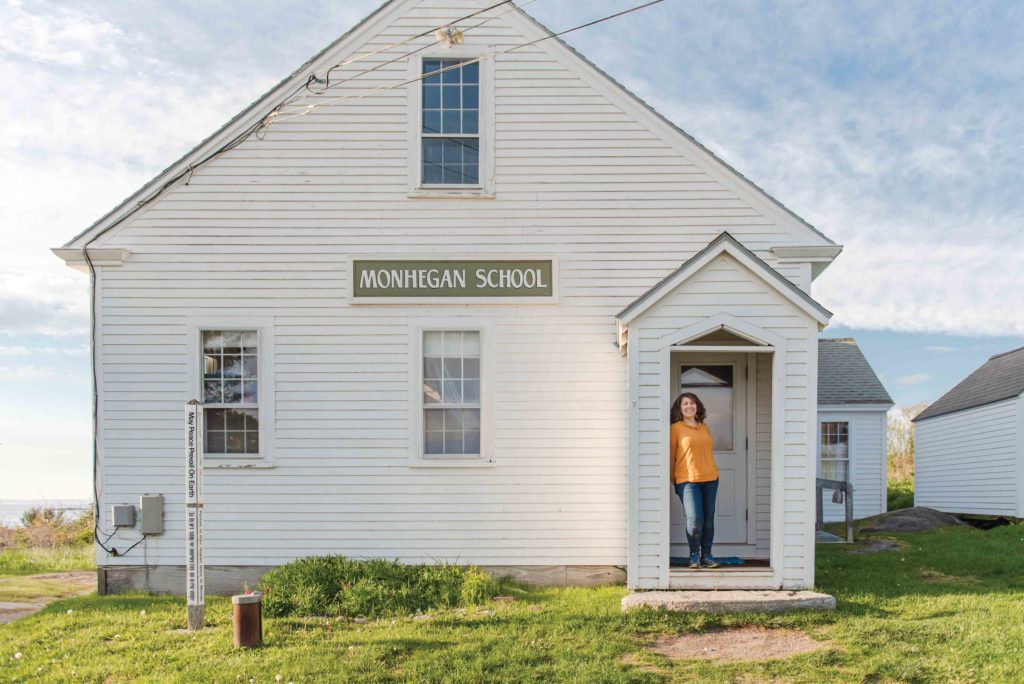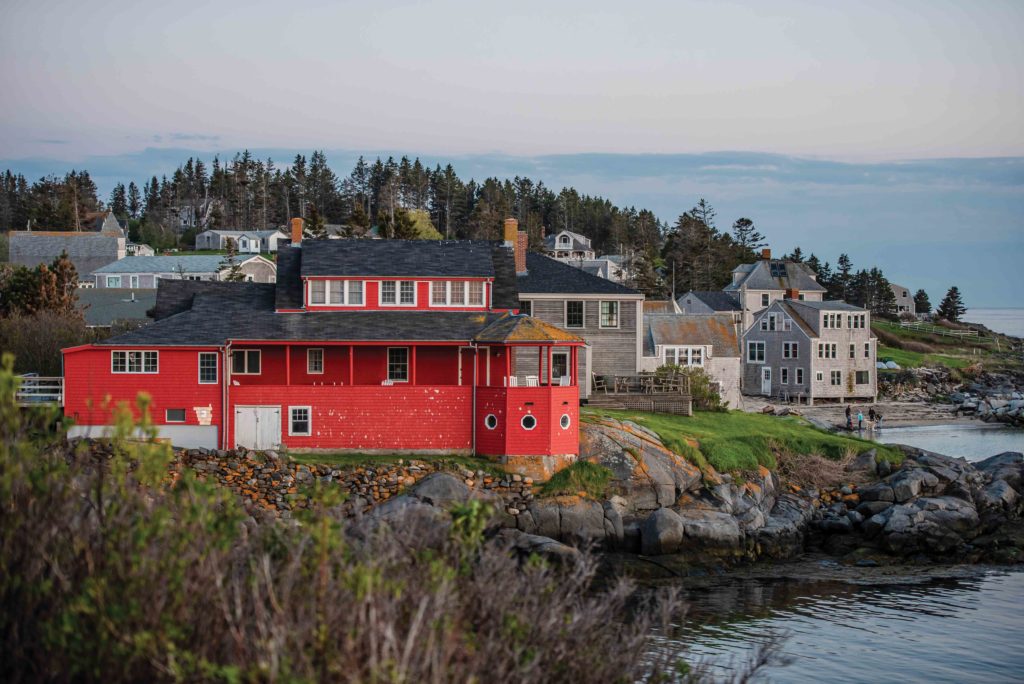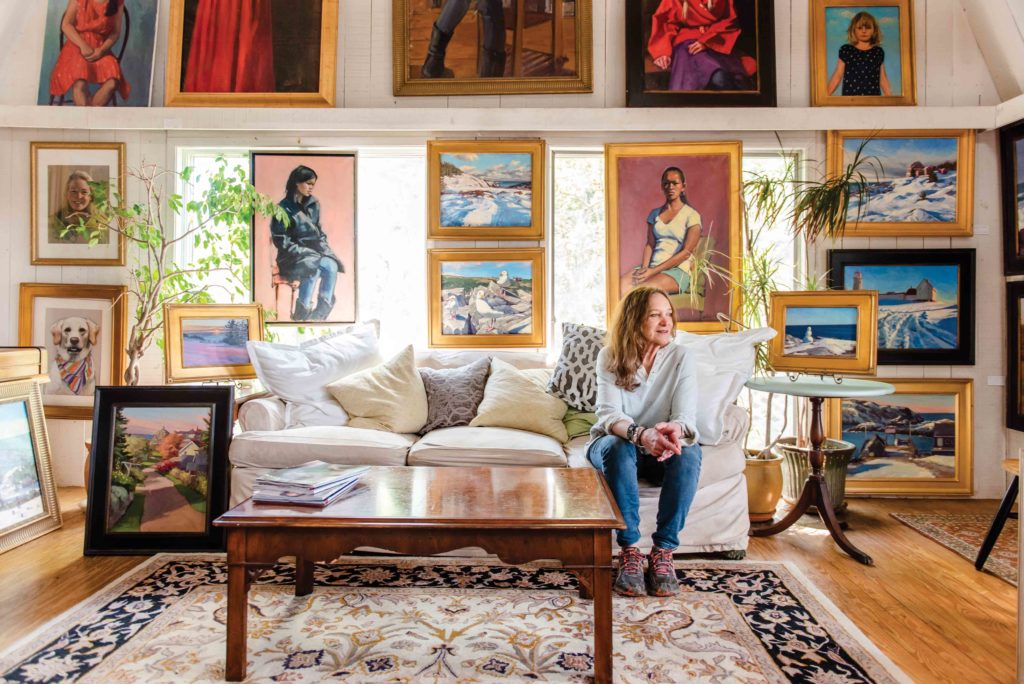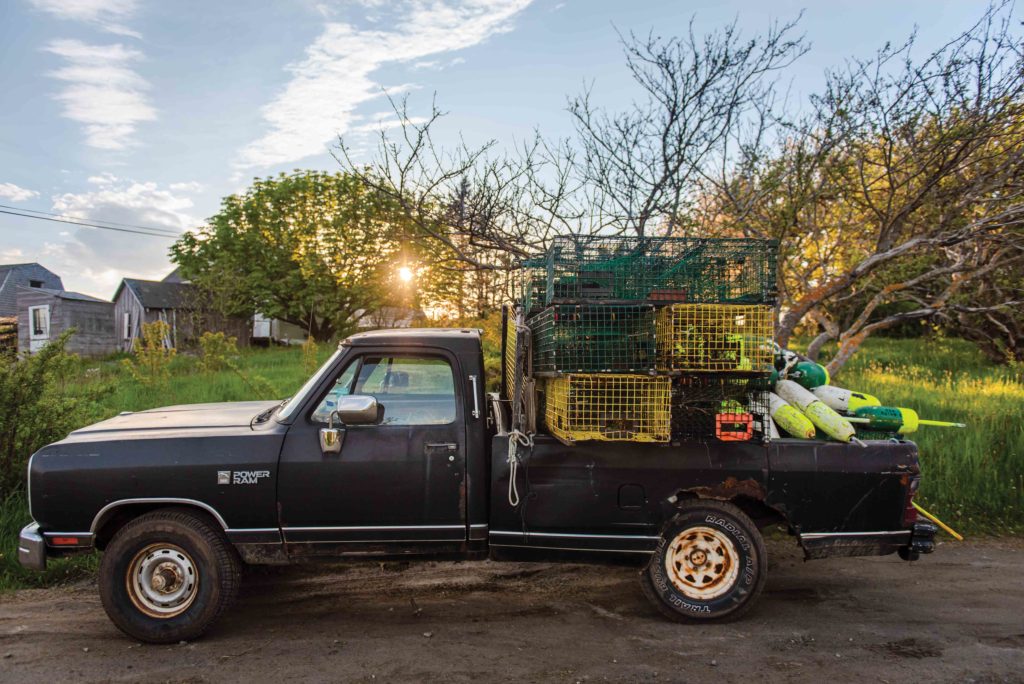Portraits on Monhegan
Facing obstacles 12 miles out to sea is a way of life for the island’s year-round residents

The salt air fills my lungs, awakening memories my mom shared of sailing in a small wooden boat on this same route from Port Clyde with her family as a child. I learned for myself, seven years ago, that it was everything she’d promised. On the coastline ahead, each new view of lobster boats, umbrellas over open-air easels, the jagged cliffs, and wild rambling gardens emerges more beautifully than the last. And again, I grab my bag and walk off the ferry up the dusty path to Monhegan’s Island Inn.
It’s easy to recognize why anyone would come to Monhegan, but I’m here to understand why they stay. Alison Hill came to be with the love of her life but then fell for plein air painting. Mandy Metrano found a place to heal and stayed to teach in a one-room schoolhouse before starting a chocolate business with her husband, Dylan. As for Matt Weber? He’s always been here for the lobster. Since 1995, Monhegan is the only place in Maine where year-round fishermen get exclusive lobstering rights to surrounding conservation waters. The catch is, they’re permitted to lobster only in the winter and spring months.

Brutal Monhegan winters aren’t for everyone, especially since the mailboat runs just once a day, and besides golf carts, work pickup trucks are the only vehicles allowed here. Living 12 miles and an hour-and-a-half ferry ride from the mainland also means going without easy access to emergency medical care. Locals take their chances, and that’s part of their charm, explains doctor and summer resident Robert Stahl, who oversees the Monhegan Museum and late artist James Fitzgerald’s house and studio, which were designed, built, and also lived in by artist Rockwell Kent. Stahl and I are at a party in the Partridge House, which is as captivating on the inside—just a thin layer of boards for walls, a stone fireplace, and gas lanterns—as the exterior seen in a 1969 watercolor by Jamie Wyeth. The room is filled with women in fanciful hats and laughter and handshakes, but I can’t take my eyes off the four floor-to-ceiling windows, where the radiant sun is dipping into the seascape and melting across the horizon. Only one sunset rivals this one for me, and it was a sunset I watched five years ago from the neighboring house.

Outside on the porch, under the glowing amber, I recognize actor Josh Mostel, son of the late comedian and Broadway star Zero Mostel, whom my mom used to see on the island. I first encountered the younger Mostel in a golf cart, a few years ago. My friend and I were late to catch the last ferry of the day. Mostel pulled over so we could squeeze into his passenger seat, then gunned it to the dock. One hand holding onto me so I wouldn’t fall out, the other on the wheel, he got us there in time, horn blaring to stop the ferry. I learned that on Monhegan you take care of your neighbors—Mostel had been mine that week. Today, he is entertaining his extended island family at a shindig to kick off summer. My invite to the party came from Hill, who is 68 but doesn’t look a day over 51—her age when she came here for the first time. “Maybe that’s the secret of living on Monhegan,” she says. “You’ll stay young forever.”
THE ARTIST

Hill followed her boyfriend, Ted Tihansky, to the artist colony of Monhegan from Newport, Rhode Island, where she’d been churning out $75 pastel portraits for Newport’s art fairs. For the summer of 2002, the couple bunked in an island dorm room at the Trailing Yew cottages, where Tihansky worked as a breakfast cook. They ate for free, and in the afternoons he taught her how to use oil paint. Hill describes Tihansky as a Van Gogh–type character—always chain smoking, splattered in paint, and neglecting everything but his brush—and at the end of the summer he told her, “You can either stay here with me or not.” “I was madly in love,” says Hill, “so I stayed.” The couple married on Monhegan, and two years later Hill sold her Newport property to buy a discounted home that came with a stipulation. The house will go back to Monhegan Island Sustainable Community Organization for her buying price if she ever decides to sell. Without the locals behind this effort, steep real estate costs and taxes make it hard to convince a newcomer to move out here.

In 2010 Tihansky got restless and wanted to live somewhere new again, with a bigger market for his art, but this time Hill was the one who wanted to stay. “It was too beautiful not to paint here, so I learned to go wild,” she says. Tihansky passed away last spring from cancer, shortly after the two had reconnected. When I walk into Hill’s home, nearly every inch of the light-drenched walls up to her second-floor open loft are covered in paintings. There is one of a young girl with bright white wings titled Trailer Park Angel. There’s another of Tihansky’s best friend, who told great stories about hopping freight trains. Many of her subjects are marginalized in some way.
Hill works oils faster than most. As I watch over her shoulder from Fish Beach, she paints the tiny Manana Island and its only house, which is shaped like an octagon and is more built-up each time I visit. Hill tells me that Danny Bates built the oddball structure over a driftwood shack that belonged to his friend, the late hermit Ray Phillips. Islanders had given Phillips their leftover wood to build the shack and, when his health began to decline, a kerosene lamp for his window. When they didn’t see the flame one night in 1975, they knew he’d passed. Bates’s wild-child son, Orca, was one of Jamie Wyeth’s favorite subjects. I know of Danny Bates through my mother, since their parents were friends. Bates gave my grandparents two goats for their small farm in North Auburn. The white specks on Hill’s canvas are the cousins of those goats, still roaming Manana with a year-round herd of sheep, although the goats winter in Kennebunk.
THE LOBSTERMAN

The year Hill and Tihansky bought their home, Matt Weber signed a 99-year land lease on the other half of their lot and built his own house. He’d grown up summering and running around the island with Orca Bates before moving here year-round in 1995, at age 19. Back then, Weber was one of 14 lobstermen on Monhegan, including three women, one of whom appears in a painting in Hill’s house. Today, there are eight lobstermen.
On my first trip to Monhegan in 2013, I hiked in the protected conservation forest that makes up 70 percent of the island’s 513 acres and includes the highest cliffs on the country’s eastern seaboard. By the end, I was exhausted, just relieved to be back on the dirt road, and there it was: Monhegan Brewing Company. Soon after I had sucked down the only beer on tap, Lobster Cove APA, on a picnic table next to a row of lobster traps. That was the year that Weber, his wife, Mary, and her brewmaster father, Danny McGovern, who co-owns Lake St. George Brewing Company in Liberty with the Webers, started the brewery. The seasonal brewery now offers ten beers on tap and sells six-packs with labels decorated by Monhegan artists. “When we opened the brewery everyone said, ‘Matt’s gonna run a brewery? He doesn’t know the first thing about tourism and how to be polite and all that,’” Weber says. “And they were right. I didn’t, but I’ve learned.” It’s become a gathering spot for tourists and islanders—the three other dining establishments on the island ask you to bring your own beer. Growing the brewery would mean more freight costs to get supplies on and off the island, which is already one of the business’s highest expenses. Besides, he’s too busy working 12 hours a day from October 1, known to islanders as Trap Day, to June 25. “I’ll never get rich lobstering here,” he says. “I will almost certainly never have a brand-new 44-foot lobster boat with a 1,000-horsepower engine, but I will always have something in my trap, even when nobody on the coastal domain is catching anything.”


Weber also published a book with Islandport Press last fall called Making Tracks: How I Learned to Love Snowmobiling in Maine. On Monhegan, where jobs change with the season, Weber also works as the water commissioner and constable, an officer with little to no authority, he jokes. “I love the people who live here, even if I don’t always agree with them. It makes it what it is.” Even if his neighbor has an annoyingly loud helicopter pad or if Bates keeps bringing more lumber to Manana to build up his house or if islanders quibble about an offshore wind power project, it’s home. When he and Mary get off the island to enjoy an anonymous walk in Portland, he misses it. “Then I hear a dump truck go by or sirens, and I think, ‘What the hell is that?’ All the stuff that people take for granted is shocking if you haven’t heard it in months.”
THE FUTURE

Brewery co-owner Mary Weber in the food truck she and her husband, Matt Weber, took over for a friend. 
Tasting truffles from La Nef Chocolate with Monhegan Brewing Company beer. 
Island artists design Monhegan Brewing Company’s labels.
There is a slightly younger crop of year-round Monhegan residents with a renewed interest in life free of traffic and waiting in line. Two of them, Dylan, 45, and Mandy Metrano, 43, are here to breathe clean ocean air in a setting once painted by Edward Hopper, George Bellows, and Kent’s mentor Robert Henri. For Mandy, Monhegan represented a fresh start. At age 16 she was in a car crash that killed her close friend and classmate at Deering High School. She was devastated, and when the tragedy made headlines it was all anyone could talk about. “The accident wasn’t why I moved to the island, but the island was such a healing place for me,” she says. “Almost no one knew anything about my past here. I could be a person of my own making.”
Mandy first came to Monhegan in 1995 as a high schooler, with a friend whose grandparents owned a house here. In college, she took a summer waitressing job at the Monhegan House inn. The island gave her the freedom to live more comfortably than she had before, after growing up without much money. She could always find work here each summer, as a chambermaid, house cleaner, barista, or cashier or doing other odd jobs, and she found it easy to form the connections that she’d been craving. “The island is quiet and disconnected from the mainland, so I could completely disappear out here and build strong relationships, while having time to work through my trauma,” she says. “People often refer to the island’s ‘healing magic,’ and it is certainly true for me.”
In 2007 Mandy met one of the servers at the Island Inn, an artist and musician named Dylan Metrano, who’d always vacationed here. Six years later they exchanged wedding bands that Dylan designed, with etchings of Monhegan and Manana on the horizon, made by their friend, jeweler Cat Bates—a Monhegan native, Orca’s half-brother, and Danny Bates’s son.

The couple moved onto the island full-time a year later so Mandy could become the only teacher in the island’s one-room schoolhouse. This year, her last as a teacher, she taught four K-8 students, all children of lobstermen. She’ll now be working full-time with Dylan running the chocolate-making business they started here in 2017, La Nef Chocolate. They sell an assortment of bars and tru ffl e varieties, with labels designed by Monhegan artists, at the island shops, and through 15 wholesalers.
Running an island business may come with a unique set of challenges, but it helps knowing you have the support of other entrepreneurs nearby. A furniture maker and the island’s assessor, Mott Feibusch, 30, and his wife Carley, 27, a woodworker, artist, and the island’s postmaster, opened Monhegan Coffee Roasters in 2018 next to the brewery. Given the island’s slowly declining year-round population, with fewer fishermen and artists each year, maybe change isn’t such a bad thing. Dylan Metrano, who has a small record label, even started a Monday-night music series to bring young musicians out to the island. I catch a performance by Sam Carp, a musician from New Hampshire, then join him at the Metranos for some homemade lentil soup. The next day, after a 5:30 a.m. lobster boat ride, I watch the early summer tourists shuffle onto the dock so I can board the ferry to Port Clyde. Past our wake, I see so much more than island vistas disappearing on the horizon, and it’s clear why anyone would choose this island life.

